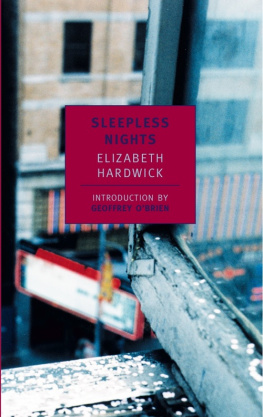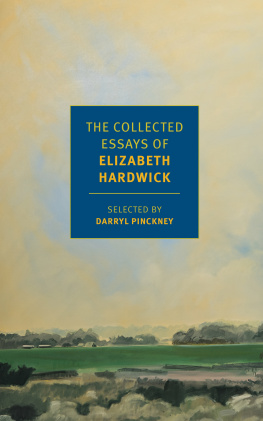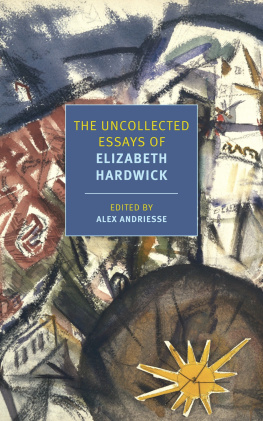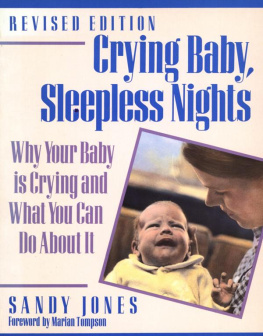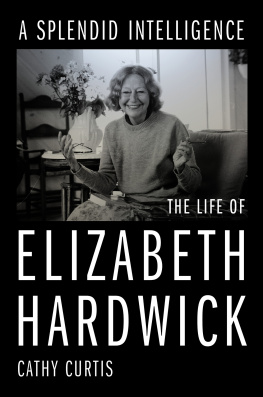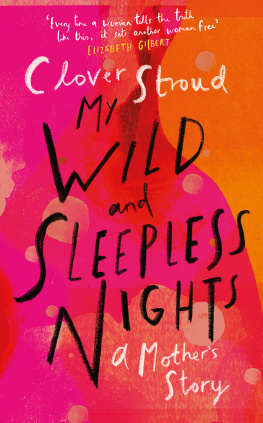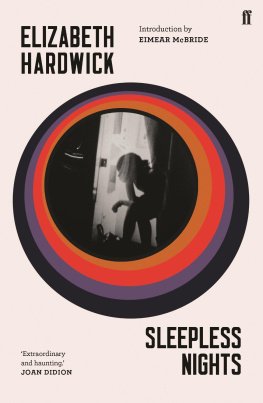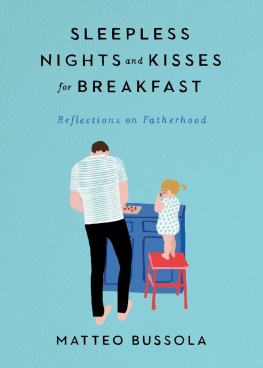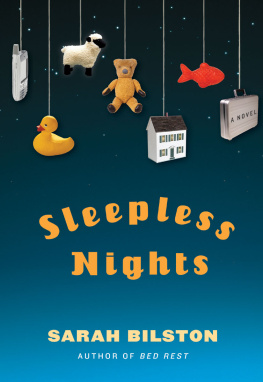Elizabeth Hardwick - Sleepless Nights
Here you can read online Elizabeth Hardwick - Sleepless Nights full text of the book (entire story) in english for free. Download pdf and epub, get meaning, cover and reviews about this ebook. publisher: New York Review Books, genre: Art. Description of the work, (preface) as well as reviews are available. Best literature library LitArk.com created for fans of good reading and offers a wide selection of genres:
Romance novel
Science fiction
Adventure
Detective
Science
History
Home and family
Prose
Art
Politics
Computer
Non-fiction
Religion
Business
Children
Humor
Choose a favorite category and find really read worthwhile books. Enjoy immersion in the world of imagination, feel the emotions of the characters or learn something new for yourself, make an fascinating discovery.
- Book:Sleepless Nights
- Author:
- Publisher:New York Review Books
- Genre:
- Rating:3 / 5
- Favourites:Add to favourites
- Your mark:
- 60
- 1
- 2
- 3
- 4
- 5
Sleepless Nights: summary, description and annotation
We offer to read an annotation, description, summary or preface (depends on what the author of the book "Sleepless Nights" wrote himself). If you haven't found the necessary information about the book — write in the comments, we will try to find it.
Sleepless Nights — read online for free the complete book (whole text) full work
Below is the text of the book, divided by pages. System saving the place of the last page read, allows you to conveniently read the book "Sleepless Nights" online for free, without having to search again every time where you left off. Put a bookmark, and you can go to the page where you finished reading at any time.
Font size:
Interval:
Bookmark:
ELIZABETH HARDWICK (19162007) was born in Lexington, Kentucky, and educated at the University of Kentucky and Columbia University. A recipient of a Gold Medal from the American Academy of Arts and Letters, she is the author of three novels, a biography of Herman Melville, and four collections of essays. She was a co-founder and advisory editor of The New York Review of Books and contributed more than one hundred reviews, articles, reflections, and letters to the magazine. NYRB Classics publishes Sleepless Nights , a novel, and Seduction and Betrayal , a study of women in literature.
GEOFFREY OBRIENs books include The Browsers Ecstasy: A Meditation on Reading, The Phantom Empire: Movies in the Mind of the Twentieth Century, and Dream Time: Chapters from the Sixties. He is editor-in-chief of The Library of America.
THIS IS A NEW YORK REVIEW BOOK
PUBLISHED BY THE NEW YORK REVIEW OF BOOKS
Copyright 1979 by Elizabeth Hardwick
Introduction copyright 2001 by Geoffrey OBrien
All rights reserved.
The Library of Congress has cataloged the earlier printing as follows:
Hardwick, Elizabeth.
Sleepless nights / Elizabeth Hardwick ; introduction by Geoffrey OBrien.
p. cm.
ISBN 0-940322-72-2 (pbk. : alk. paper)
1. WomenFiction. I. Title.
PS3515.A5672 S58 2001
813'.52dc21
2001003029
Cover image: Jack Pierson, Last Day on 42nd St.; Courtesy of Jack Pierson and Regen Projects, Los Angeles
Cover design: Katy Homans
eISBN 978-1-59017-438-8
v1.0
For a complete list of books in the NYRB Classics series, visit www.nyrb.com or write to:
Catalog Requests, NYRB, 435 Hudson Street, New York, NY 10014
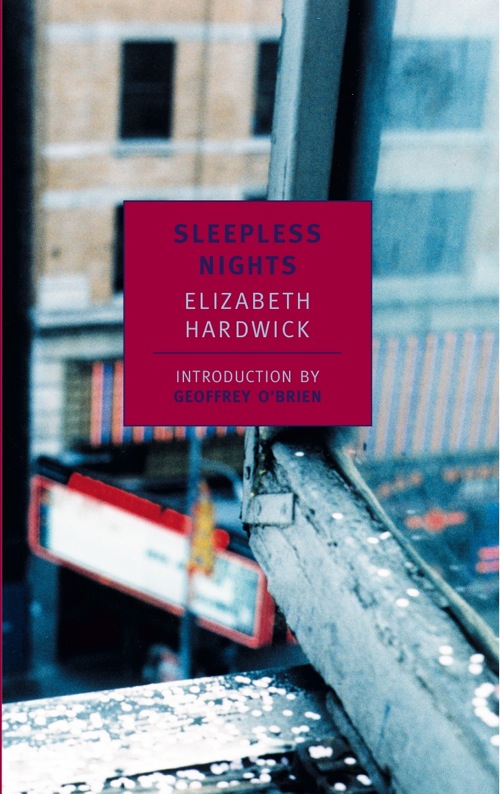
To my daughter, Harriet, and to my friend, Mary McCarthy
T HIS DENSE , compressed, singular work was described when published in 1979 as a novel. It bore, however, a peculiar relation to the genre. It was a novel without a plot, with a protagonist who shared the name of its author, and whose successive circumstances followed the known contours of Elizabeth Hardwicks life; a novel that could allow itself to move in any direction in time that it chose, that could shift its attention from one person or situation to another as abruptly as a filmmaker might splice together two incongruous images; a novel that seemed to declare the impossibility of separating itself from life, yet admittedly one seeming to be true when all of it is not. (A good deal of the book, Hardwick stated in an interview at the time, is, as they say, made up.) Sleepless Nights might be taken as an exploration of the problem of genre, the problem of distinguishing fiction from what is so coarsely described as nonfiction, except that the book is more like a demonstration that the problem is illusory.
The book inhabits that divide in so inevitable a fashion as to dissolve what was thenand is often stillperceived as a natural barrier. The norms of fiction, the reader of Sleepless Nights might well conclude, are after all a constriction, or at least a superfluity: Since to live is to make fiction, what need to disguise the world as another, alternate one? At the same time strict reportage, with its prohibition against invention, imposes its own aesthetically intolerable demands. Sleepless Nights, an alchemical tour de force, reports by inventing and invents by reporting. It continues to remind us how the novel can become richer by permitting itself the resources of essay, journal, memoir, prose poem, chronicle. It is a commonplace that every book needs to find its own form, but how many do?
Sleepless Nights enlarges on Hardwicks earlier novels (The Ghostly Lover and The Simple Truth) by allowing itself the structural and stylistic freedoms of her literary essays. For Hardwick the essay has always been a form allowing for sudden transformations. Frames dissolve; writers become characters; characters reenter the world as independent beings; real events assume the stylization and symbolic weight of scenes in novels. There is a constant interpenetration of the fictive and the experienced. A description of the last days of Dylan Thomas has the density found in some ancient chroniclerPlutarch or Tacituswhose every sentence has a ring of calm fatality: The people near him visited indignities upon themselves, upon him, upon others. There seems to have been a certain amount of competition at the bedside, assertions of obscure priority. The honors were more and more vague, confused by the ghastly, suffering needs of this broken host and by his final impersonality. Discussing Samuel Richardsons Clarissa in her famous essay Seduction and Betrayal, Hardwick does not merely allude to or analyze Clarissa and Mr. Lovelace but rather allows them the scope of living beings, discontented forces escaping from their fictional frame: Words are her protection. Her cries to heaven go out in the next post. Her powers are not perfect, but they reduce the insuperable Lovelace to rape, the most unworthy resource. Are they lovers, or opponents? They have furiously, curiously tested each other and the consummation is death.
Writingpart of life and yet not of itis the medium that permits movement through, across, beyond. In Sleepless Nights, the narrator begins: It is June. This is what I have decided to do with my life just now. It is life, then, that we hold in our hands: real time, the actual room in which the wordsthis work of transformed and even distorted memoryare being written. The past will be made part of the bookthe past is what the book is all aboutbut only by being incorporated into the present moment in which one word is added to another. All that has been or might have been real once will be made into an object. If only one knew what to remember or pretend to remember. Make a decision and what you want from the lost things will present itself. You can take it down like a can from a shelf. Perhaps. In that perhaps is the whole art of Sleepless Nights. The experiences that are evoked, described, brought to life, are at the same time shown to be words, tokens, emblems. The book stands for everything that is not the book, that could never be in a book. The building up of a world in prose is countered by its equally meticulous dismantling, until we are left withwhat, exactly? This object, this structure that haunts as much by what it leaves out as by what it contains.
She writes of her mother: I never knew a person so indifferent to the past. It was as if she did not know who she was. Omission here is description, more faithful than the fruits of careful research could be: it is life with the blanks left in, and all the questions that flourish in those blanks. Unanswered, unanswerable questions are a recurring feature of the book. The prose often finds its resolution not in a full stop but a question mark. Both novel and memoir are conventionally expected to provide definite answerswho really did what and what finally became of them and what it meant. Sleepless Nights is more comfortableindeed, can only be comfortableamong uncertainties, insufficiencies, unsatisfyingly partial or obstructed views. Billie Holiday appears (the real Billie Holiday, and it was at this point that one began to gauge how unlike other novels this was), intimately penetrates the lives of others, but is not, finally, to be apprehended: The mind strains to recover the blank spaces in history and our pale, gray-green eyes looked into her swimming, dark, inconstant poolsand got back nothing.
Next pageFont size:
Interval:
Bookmark:
Similar books «Sleepless Nights»
Look at similar books to Sleepless Nights. We have selected literature similar in name and meaning in the hope of providing readers with more options to find new, interesting, not yet read works.
Discussion, reviews of the book Sleepless Nights and just readers' own opinions. Leave your comments, write what you think about the work, its meaning or the main characters. Specify what exactly you liked and what you didn't like, and why you think so.

